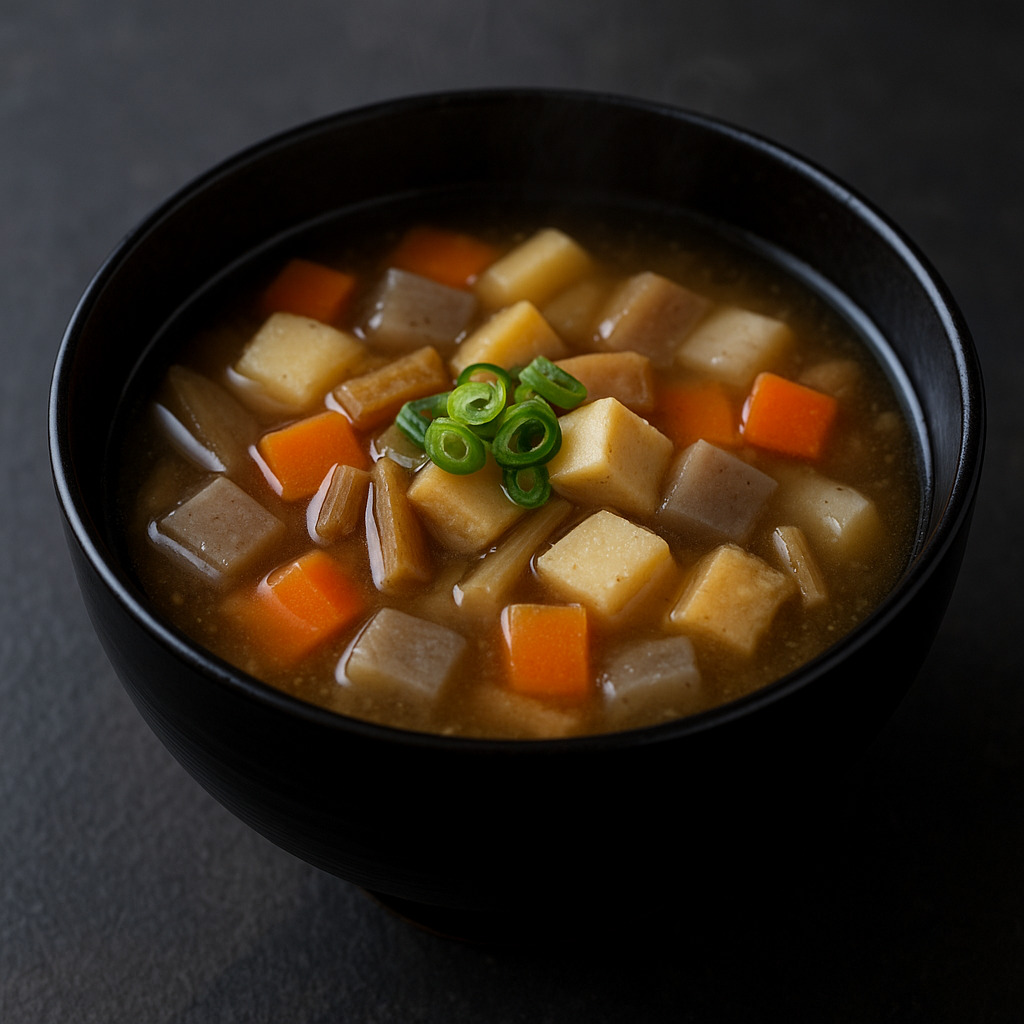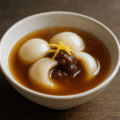けの汁の特徴
津軽の冬を支える具だくさん郷土汁
けの汁は、青森・津軽地方で親しまれる具だくさんの味噌仕立ての汁物。角切りにした野菜や山菜、豆腐や油揚げをたっぷり入れ、体の芯から温まります。
サイの目切りで食べやすく
具材は5〜7mmほどの角切りにそろえるのが基本。口当たりが均一になり、汁に旨みが溶け出して一体感のある味わいになります。
翌日はさらにおいしい
時間とともに味がなじみ、翌日はよりまろやか。寒い季節の作り置きにも向く一杯です。
けの汁のレシピ
材料(4人分)
- 大根 … 150g(5〜7mm角)
- にんじん … 80g(5〜7mm角)
- ごぼう … 1/2本(5mm角・水にさらす)
- 木綿豆腐 … 1/2丁(1.5cm角→崩れ防止に軽く下茹で可)
- 油揚げ … 1枚(熱湯をかけて油抜き→5mm角)
- こんにゃく … 1/2枚(5mm角・下茹で)
- 乾しいたけ … 2枚(戻して5mm角・戻し汁はだしに)
- 長ねぎ … 1/2本(小口切り)
だし・調味
- 水 … 900ml(+しいたけの戻し汁)
- 昆布 … 5×10cm 1枚
- 煮干し … 10g(またはかつお節 5g)
- 米味噌 … 大さじ3〜4(好みで調整)
- 酒 … 大さじ1
- みりん … 小さじ1(お好みで)
- 醤油 … 小さじ1/2(味の輪郭を整える用・任意)
作り方
- 下ごしらえ:乾物は戻し、山菜は塩抜き。ごぼうは水にさらしてアクを抜く。油揚げは油抜き、こんにゃくは下茹で。
- だしを取る:鍋に水・昆布・煮干し・しいたけ戻し汁を入れ、弱火で温める。沸騰前に昆布を外し、ひと煮立ち直前で火を弱めて10分ほど旨みを引き出し、煮干しを取り除く。
- 煮る:硬い順に大根・ごぼう・にんじん・こんにゃくを加え、やわらかくなるまで中火で10分ほど煮る。油揚げ・豆腐を入れ、酒・みりんを加える。
- 味噌を溶く:味噌の半量を溶き入れて3分。仕上げに残りを加えて味を決め、必要なら醤油少々で輪郭を整える。
- 仕上げ:長ねぎを加えてひと煮立ち。火を止めて数分休ませ、器に盛る。
シェフのワンポイントアドバイス
具材は均一サイズの角切りがコツ。味噌は二段投入(途中と仕上げ)で香りを残します。
仕上げにすりごま少々やごま油1〜2滴で風味アップ、塩分は味噌量で調整しましょう。
栄養価(1杯の目安)
- エネルギー:約180〜260 kcal
- たんぱく質:9〜14 g
- 脂質:6〜10 g
- 炭水化物:20〜30 g
- 食物繊維・カリウム・葉酸(野菜・山菜由来)
具だくさんでも油控えめでバランス良好。豆腐や油揚げでたんぱく質を補えます。
歴史
冬の保存食文化に根ざす日常の汁
塩蔵・乾物などを活用する知恵から生まれ、寒さの厳しい季節に栄養をととのえる“日常のごちそう”。語源には諸説ありますが、素朴で飽きのこない味が受け継がれています。
家庭ごとに違う“我が家の味”
味噌の種類やだし、山菜の有無、豆製品の選び方などは家庭や地域でさまざま。翌日の温め直しで一層おいしくなるのも共通の魅力です。
English Version
Features of Keno-jiru
A Hearty Local Soup that Sustains Tsugaru Winters
Keno-jiru is a beloved miso-based soup from the Tsugaru area of Aomori. It’s packed with diced vegetables, tofu, and abura-age, delivering deep comfort and warmth.
Easy Eating with Uniform Dice
Cut ingredients into even 5–7 mm cubes. The uniform size creates a consistent mouthfeel and helps flavors meld into a cohesive, savory broth.
Even Better the Next Day
Flavors settle and round out over time, making it ideal for make-ahead cooking during the colder months.
Recipe
Ingredients (serves 4)
- Daikon radish … 150 g (5–7 mm dice)
- Carrot … 80 g (5–7 mm dice)
- Burdock root … 1/2 stalk (5 mm dice; soak in water)
- Firm tofu … 1/2 block (1.5 cm cubes; brief blanching helps keep shape)
- Abura-age (fried tofu) … 1 sheet (pour hot water to degrease; 5 mm dice)
- Konnyaku … 1/2 slab (5 mm dice; parboil)
- Dried shiitake … 2 (rehydrate; 5 mm dice; reserve soaking liquid)
- Long green onion (negi) … 1/2 stalk (thinly sliced)
Broth & Seasoning
- Water … 900 ml (plus shiitake soaking liquid)
- Kombu … 1 sheet (5 × 10 cm)
- Niboshi (dried sardines) … 10 g (or katsuobushi 5 g)
- Rice miso … 3–4 tbsp (to taste)
- Sake … 1 tbsp
- Mirin … 1 tsp (optional)
- Soy sauce … 1/2 tsp (optional; to sharpen the finish)
Instructions
- Prep: Rehydrate dried items; if using preserved mountain vegetables, desalinate. Soak burdock to remove astringency. Degrease abura-age; parboil konnyaku.
- Make the broth: Combine water, kombu, niboshi, and shiitake soaking liquid in a pot and warm gently. Remove kombu before boiling; keep just below a boil and extract for about 10 minutes, then remove niboshi.
- Simmer: Add firm vegetables in order—daikon, burdock, carrot, then konnyaku—and simmer over medium heat for about 10 minutes until tender. Add abura-age and tofu; season with sake and mirin.
- Add miso: Stir in half the miso and simmer 3 minutes. Add the remaining miso to finish, adjusting with a little soy sauce if needed.
- Finish: Add negi and bring just to a brief simmer. Turn off the heat, rest a few minutes, and serve.
Chef’s Tip
Keep all cuts uniformly diced for the best texture. Use a two-stage miso add (midway and at the end) to preserve aroma. For extra fragrance, finish with a pinch of ground sesame or 1–2 drops of sesame oil. Adjust saltiness by the miso amount.
Nutritional Value (per bowl, approx.)
- Calories: 180–260 kcal
- Protein: 9–14 g
- Fat: 6–10 g
- Carbohydrates: 20–30 g
- Dietary fiber, potassium, folate (from vegetables)
Balanced and relatively low in oil despite generous ingredients. Tofu and abura-age add convenient protein.
History
An Everyday Soup Rooted in Winter Preservation
Born from traditions of using salted and dried pantry items, this “everyday feast” helps maintain nutrition through harsh winters. The name’s origin is debated, but its humble, comforting taste endures.
A Household Taste with Many Variations
Miso style, broth base, choice of mountain vegetables, and soy products vary by home and region. One shared truth: it’s often even tastier when reheated the following day.



何でも質問してください!